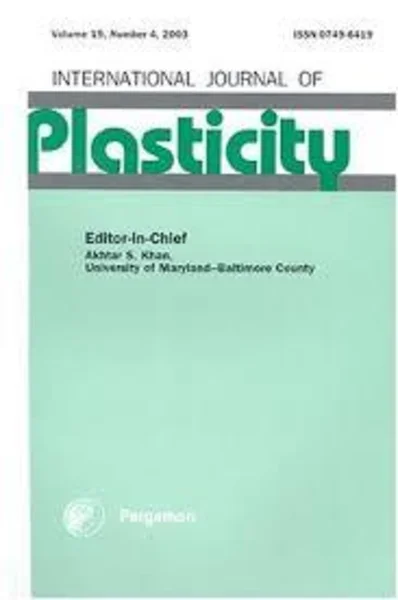-
a novel yield locus description by combining the taylor and the relaxed taylor theory for sheet steels
جزئیات بیشتر مقاله- تاریخ ارائه: 1390/01/01
- تاریخ انتشار در تی پی بین: 1390/01/01
- تعداد بازدید: 660
- تعداد پرسش و پاسخ ها: 0
- شماره تماس دبیرخانه رویداد: -
recently, several flexible constitutive equations have been proposed for sheet forming simulations. however, various mechanical tests are required to determine the material parameters needed for such models. in the present work, effort has been made to investigate the correlation between the polycrystal plasticity based yield loci and those determined from mechanical tests, in order to define yield functions easily and accurately with minimum experimental work. the results for different materials indicate that, in many cases, the hill’48 quadratic yield function conventionally fitted with the plastic anisotropy r-values deviates significantly from measured yield loci. the hill’48 yield function fitted with the uniaxial and biaxial yield stresses is quite close to the measured one, but with large deviation in the strain ratios for strong anisotropic materials. a careful comparison of the measured yield loci and those calculated from the taylor full constraint model and the relaxed model indicates that the yield loci derived from the taylor full constraint model capture the shape of the measured ones in general, but they are less elongated in the stretching direction, and the stretching factor is usually smaller than that derived from the relaxed taylor model. the measured biaxial points are between those calculated from the two taylor models. based on the two yield loci derived from the taylor models, a new combined model referred to as ctfp is proposed. the new model retains roughly the shape of the yield loci derived from the taylor full constraint model, but the size is scaled using the averaged biaxial points of each model in the stretching regime. the proposed new description has been validated using several forming steel grades. this model can be used as virtual experiment for complicated mechanical tests, such as the plane strain tension, balanced biaxial stretching and shear test. the stress and strain data from the virtual experiments, together with the stress and plastic anisotropy measured in the uniaxial tensile test, are easily deployed as input data for other constitutive equations used in sheet metal forming simulations. forming limit diagrams were predicted using different material constitutive models. the difference between the measured fld and the calculated ones is remarkable. a profound analysis of the phenomena and a systematic study of intrinsic material parameters on the flds is needed.
مقالات جدیدترین رویدادها
-
استفاده از تحلیل اهمیت-عملکرد در ارائه الگوی مدیریت خلاقیت سازمانی و ارائه راهکار جهت بهبود
-
بررسی تاثیر ارزش وجوه نقد مازاد بر ساختار سرمایه شرکت های پذیرفته شده در بورس اوراق بهادار تهران
-
بررسی تأثیر سطح افشای ریسک بر قرارداد بدهی شرکت های پذیرفته شده در بورس اوراق بهادار تهران
-
بررسی تأثیر رتبه بندی اعتباری مبتنی بر مدل امتیاز بازار نوظهور بر نقد شوندگی سهام با تأکید بر خصوصی سازی شرکت ها
-
تأثیر آمیخته بازاریابی پوشاک ایرانی بر تصویر ذهنی مشتری پوشاک ایرانی (هاکوپیان)
-
اهمیت استراتژی مدیریت اکوسیستم در منطقه گردشگری دریای عمان
-
بررسی منشا گارنت های موجود در گرانودیوریت های منطقه دهنو، شمال غرب مشهد، استان خراسان رضوی
-
نقش سرمایه فکری در بهبود فرآیندهای اقتصادی
-
مقایسه تأثیر لیزر کم توان و اولتراسوند در مبتلایان به سندرم درد عضلانی- فاشیایی
-
effect of (zn(oh)2)3(znso4)(h2o)5 on the performance of ru–zn catalyst for benzene selective hydrogenation to cyclohexene
مقالات جدیدترین ژورنال ها
-
مدیریت و بررسی افسردگی دانش آموزان دختر مقطع متوسطه دوم در دروان کرونا در شهرستان دزفول
-
مدیریت و بررسی خرد سیاسی در اندیشه ی فردوسی در ادب ایران
-
واکاوی و مدیریت توصیفی قلمدان(جاکلیدی)ضریح در موزه آستان قدس رضوی
-
بررسی تاثیر خلاقیت، دانش و انگیزه کارکنان بر پیشنهادات نوآورانه کارکنان ( مورد مطالعه: هتل های 3 و 4 ستاره استان کرمان)
-
بررسی تاثیر کیفیت سیستم های اطلاعاتی بر تصمیم گیری موفق در شرکتهای تولیدی استان اصفهان (مورد مطالعه: مدیران شرکتهای تولیدی استان اصفهان)
-
مطالعه تاثیر بانکداری الکترونیکی بر نیت رفتاری مصرف کنندگان در صنعت بانکداری
-
بررسی درآمدهای مالیاتی خراسان شمالی و ارتباط بین درآمد مصوب شده و عملکرد از سال 90-96
-
نقش توان مندی مدیران در کشف کلاه برداری گزارشگری مالی با در نظر گرفتن حضور و نفوذ صاحب منصبان دولتی در ارکان اداره شرکت ها با تعیین درجه سیاست دولتی بر اساس شاخص sa
-
surface adsorption of carbon monoxide and hydrogen gases mixed with boron nitride (7 ,7) nanotubes by monte carlo method
-
the effects of employees’ integrity, responsibility, compassion and forgiveness on corporate social responsibility in iranian private sector in east and west of azerbaijan in iran




سوال خود را در مورد این مقاله مطرح نمایید :